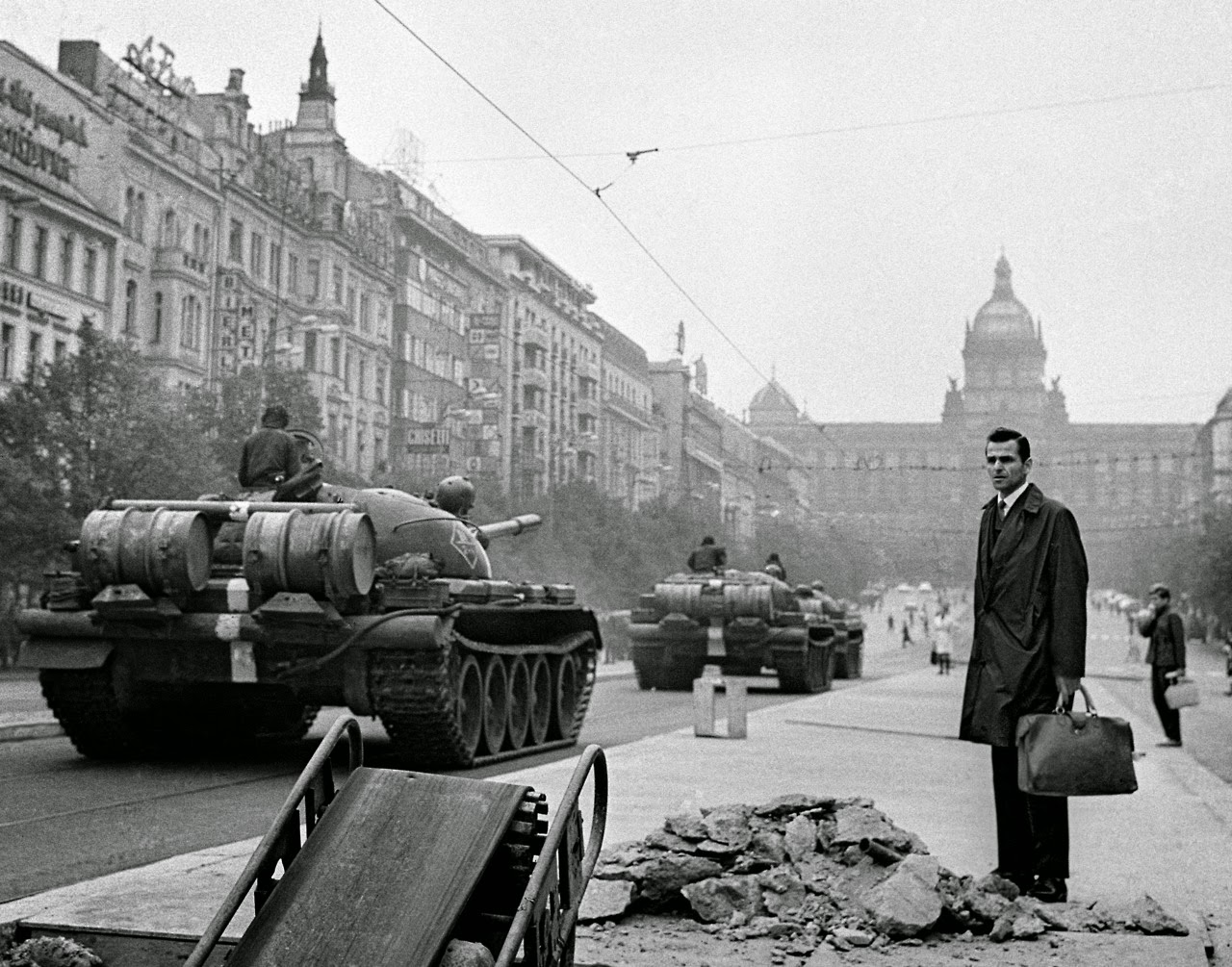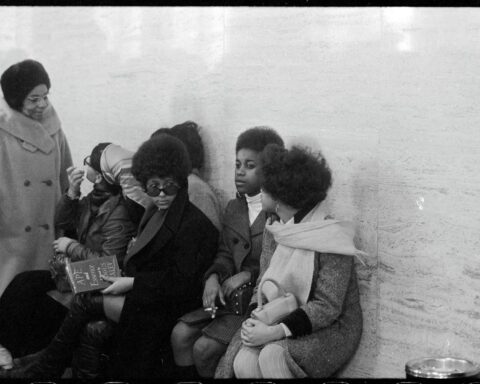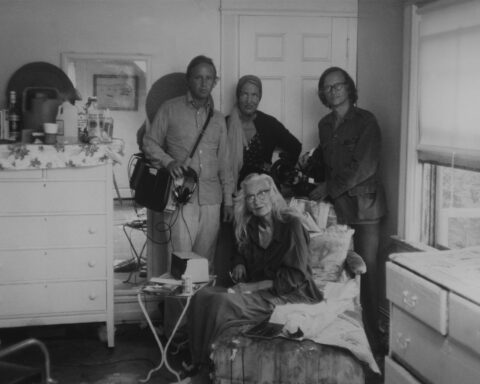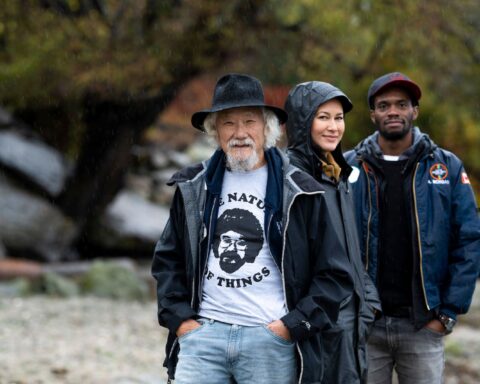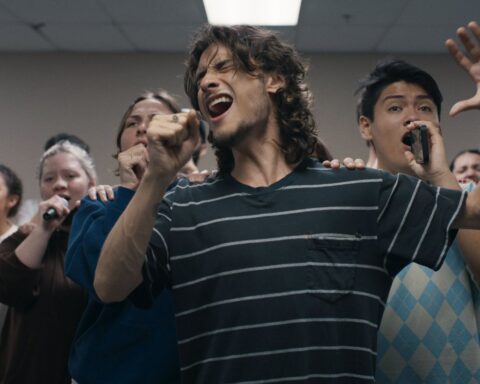1968 was a year of cultural and political seismic shifts, marked more by assassinations, strikes and demonstrations than the peace, love and rock ‘n’ roll clichés remembered fondly by Boomers and derided by their children and, increasingly, grandchildren. Only a narrow focus can make us miss the most important thing about 1968: its contradictions. What seems clear, with the wonderful 20/20 vision that hindsight allows, is that older versions of the world came apart and nothing has been the same since.
One of the best aspects of 1968—and of any time since then—is that documentation exists for us to sift through all the major events that then transpired. Through recent TV series such as Ken Burns and Lynn Novick’s The Vietnam War and contemporary docs like Emile de Antonio’s In the Year of the Pig, Fernando Solanas and Octavio Getino’s The Hour of the Furnaces (La Hora de los Hornos), Jan Němec’s Oratorio for Prague, and the material shot by Chris Marker and his colleagues for Grin Without a Cat (Le fond de l’air est rouge), it’s possible to see documentation of the pivotal events of the year. Sources such as Getty Images and YouTube also make much audio and visual documentation easily accessible—everything from music videos of the period to the brilliant and disturbing photos from Vietnam, the U.S. and elsewhere by photographers in Czechoslovakia (Josef Koudelka), the U.S. (Gordon Parks) and overwhelmingly in Vietnam (Don McCullin, Eddie Adams, Tim Page, David Douglas Duncan and others). Marshall McLuhan’s famous assertion that “the medium is the message” may predate 1968 by a year, but that’s alright. We can see it playing out in the films, photos and TV broadcasts of the time.
If one thing marks 1968, it’s violence. On January 30, it exploded in Vietnam, where the U.S.-supported South Vietnamese regime’s civil war with North Vietnam was the focal point of world attention. The Cold War was at its height—some things have changed—and America’s attempt to keep South Vietnam under its control was explained by a domino theory involving the threat that all of Southeast Asia would become communist if South Vietnam fell. Relaxed after holiday celebrations, the Americans weren’t prepared for a sudden onslaught by North Vietnamese forces accompanied by those of the National Liberation Front (NLF; the U.S. military called it the Viet Cong).
Over the course of the next two months, more than 80,000 North Vietnamese and Viet Cong troops struck more than 100 urban areas, including 36 of 44 provincial capitals, including South Vietnam’s capital, Saigon (now Ho Chi Minh City). There’s much dispute over who won the Tet offensive. Certainly more North Vietnamese and NLF troops lost their lives. But who won the media campaign?
As Ken Burns and Lynn Novick show in their recent 10-part, 18-hour PBS documentary series The Vietnam War, America lost faith in the war over those two months. The main event was one created by the media, a photograph of an NLF soldier being shot in the head by a South Vietnamese general. Taken by Eddie Adams, the photograph was published in early February by the New York Times, and won the Pulitzer Prize. Scholar and political communications expert David D. Perlmutter has written “no film footage did as much damage…[as] Adam’s 35mm shot taken on a Saigon street.” That same February, a Gallup poll showed that 50% of Americans disapproved of the Vietnam War, while the approval rating went down to 35%.
If the radical American documentary director Emile de Antonio had some inkling of Ho’s loss of power, it didn’t affect his perspective in In the Year of the Pig, the most powerful documentary made about the Vietnam War in 1968. The Oscar-nominated film imparted a history lesson for North American viewers, revealing what had actually taken place in Vietnam since the early 1940s.
De Antonio was able to access archives from Communist sources as well as those from France and other Western countries. This access allowed him to create a sympathetic treatment of Ho Chi Minh and the North Vietnamese, who had a very credible case for expecting free elections and the unification of Vietnam when France gave up its imperialist hold on Indochina after their 1954 defeat in Dien Bien Phu. Both the Burns/Novick documentary series and de Antonio’s full-length film were able to show the human side of Ho, and the reasons why so much of the citizenry supported him and the Party—but their conclusions about the Vietnam War are different.
For de Antonio, finishing and releasing his film in 1968, the war was an immediate concern; he wanted to use his film to change its course. Life was never more volatile than in that fateful year. On the night before In the Year of the Pig’s Los Angeles premiere, right-wing vandals broke into the movie house, spray-painting a Communist hammer and sickle, and a peace sign, on the screen beneath the words “Traitors” and “Prolong the War. You slobs killed 40,000 good men!” Not to be outdone, the theatre took out an ad with a photograph of the graffiti, adding, “If what you did to our screen=your intolerance of dissent, then we are indeed in the Year of the Pig.”
De Antonio’s documentary didn’t achieve its ultimate purpose of ending the war in Vietnam. Nearly 50 years later, Burns and Novick had a different mission: to remind Americans, and the world, what had happened during the Vietnam War. The filmmakers saw the war as a tragedy that their nation still hasn’t come to grips with, even today. One could point out that the American schisms which came to the fore in the Sixties—opposition to the America First ideology, the struggle for the rights of African Americans, the rise of the gay, feminist, Indigenous and ecological movements—have only grown deeper and more impassable since.
On April 4, 1968, violence came home to roost in America. Martin Luther King Jr., the country’s African-American apostle of non-violent resistance, was shot to death in a Memphis motel. He had been organizing a Poor People’s Campaign to unite economically dispossessed Americans—whites, blacks, indigenous, everyone—who were barely surviving in a land of plenty. King saw this as the necessary next step in his campaign for human rights. For many Americans, the Campaign was a huge threat: King was now looking at the world through a lens not only of race, but also of economics and class.
King was a larger-than-life figure with a unique command of rhetoric. His impassioned speeches, most notably the brilliant “I Have a Dream” oration—an eloquent evocation of freedom and human rights—are captured in many of the documentaries about him, which started as early as 1970, with the Sidney Lumet and Joseph L. Mankiewicz-directed King: A Filmed Record… Montgomery to Memphis.
Senator Robert Kennedy, whose campaign for the Democratic Party’s presidential nomination had begun just three weeks earlier, spoke to a crowd of mainly black Americans who had not heard of King’s assassination. Kennedy’s eloquent words can be heard in Bobby Kennedy for President, a four-part doc series made for Netflix. Quoting his favourite poet Aeschylus, he read that after “pain which (we) cannot forget…comes wisdom through the awful grace of God.” He went on: “What we need in America is not division, what we need in the United States is not violence and lawlessness, but is love, and wisdom, and compassion towards one another.” Kennedy’s words, though remarkable, couldn’t prevent a wave of riots across the country in the wake of King’s death.
What the Dawn Porter-directed, Netflix-produced Kennedy series makes clear is that Kennedy’s campaign was based on his understanding of the plight of the Mexican-and African-Americans who were living in unequal, unfair situations in an America of plenty. It was those communities—led by political spokespeople like King, and Cesar Chavez of the United Farmworkers Association—that identified strongly with Kennedy as he spoke passionately for their causes. Footage from the period in the Kennedy documentary series makes it beautifully clear that this was no ploy. Bobby did understand and love those communities and wanted to advocate for them.
Two months later almost to the day, it was all over. On June 6, Bobby Kennedy had barely completed his victory speech in the California primaries when he was shot to death by Sirhan Sirhan, a Palestinian Christian whose motivation to kill Kennedy may have been the Senator’s pro-Israeli stance. Kennedy’s body was sent to St. Patrick’s Cathedral in New York City, where there was a funeral mass attended by 2,000 people. His casket was then sent by train from New York to Washington, D.C., where he was to be buried in Arlington National Cemetery. Over a million people lined up in train stations along the 225-mile journey. The demonstration was documented by Life magazine photographer Paul Fusco, some of whose images have been on display at the International Center for Photography in Manhattan all summer.
The Poor People’s Campaign continued without King, and had marched on Washington. As Kennedy’s funeral cortège drove to Arlington, it circled the Lincoln Memorial at one end of the Mall. For a final moment, supporters of King and Kennedy met in sorrow and anger at what had happened to the United States. Documentation of this event is shown in the PBS award-winning series Eyes on the Prize, which reveals much about King’s laudable efforts to change society in the Sixties.
Revolutionary events were taking place around the world in 1968, and Latin America was one of the key contested areas between capitalism and communism. Iconic moments had occurred in 1967, with the assassination in Bolivia of the legendary guerrilla leader Che Guevara; and in 1970, with the election of Marxist Salvador Allende to the presidency of Chile. In 1968, the major event was the samizdat-style release of Fernando Solanas and Octavio Getino’s The Hour of the Furnaces, a film deemed so subversive that the majority of screenings were held in private meeting halls, where the government was unlikely to intervene.
Hour of the Furnaces begins with insistent drumbeats, showing scenes of revolutionaries being beaten by the police, or picking up rocks and sticks to fight against oppression. These documentary scenes are interspersed with titles that proclaim the viewers are “dispossessed” and have been taught a “false history, a false economy and false freedoms.” The titles predict “a long war” in which the committed viewer will become a rebel. In the most acerbic of the thirteen chapters in the film’s first part, “Neocolonialism and Violence,” entitled “Ideological Warfare,” hip young Buenos Aires 20-somethings are presented in a bravura montage, created by the great Cuban editor Santiago Álvarez, going to clothing and record shops before hitting the discos. While the clever soundtrack plays Ray Charles’ “I Don’t Need No Doctor” and pop music by Los Bravos and Herb Alpert, the narrator points out that these sophisticated youths aren’t living an Argentine reality—they’ve been seduced into American culture. The final of part one of Hour of the Furnaces gives us one of the indelible images of the Sixties: the dead Che, an Argentine who fought with Castro and died in the Bolivian mountains, eyes staring as if to a better future and the body arranged like that of Jesus on the cross.
The revolutionary spirit of 1968 didn’t miss France, a country where intellectuals and artists were dealing with an imperialist and racist past. The events in France are usually told two ways: one, focusing on the dramatic but shaky alliance of students and workers that actually shut down Paris and much of France in May; and the other, a tale of cinema, which begins with the firing of Henri Langlois, head of the Cinémathèque Française, in February and ends with the closure of the Cannes Film Festival in late May.
The tale of cinematic revolution has had the widest effect internationally, as it involved such major filmmakers as Truffaut, Godard and Marker—though it’s fair to say that the closure of the Sorbonne, the Paris Stock Exchange and hundreds of factories was no mean feat. For a few weeks in May, it seemed that De Gaulle’s Fifth Republic would collapse. But concessions by his prime minister Georges Pompidou effectively drove apart the alliance, separately satisfying both the students and the workers. Similarly, the filmmakers got what they wanted. Langlois was restored to his position at the Cinémathèque, and the Cannes festival returned with a new innovation: the Directors’ Fortnight, a non-competitive program of distinguished auteur films.
The revolutionary fervor in France is caught best in the opening sequence of Le fond de l’air est rouge (1977), Chris Marker’s look back at the Sixties and early Seventies. Marker skillfully uses footage from Battleship Potemkin (1925), creating Eisenstein-like montage sequences. Cut between the Russian revolutionary past and present-day demonstrations and violent confrontations with the police, Marker uses the stirring music of legendary composer Luciano Berio to bring the strife-laden days of 1968 and beyond into an historical continuum.
As summer 1968 progressed, tension began to build in Prague and Chicago. Starting in January, with the appointment of Alexander Dubček to the office of First Secretary, a new philosophy had emerged in Prague: “socialism with a human face.” The Czech experiment was the first genuine attempt at reforming Communism in the Soviet-controlled Eastern Bloc nations. The Prague Spring lasted from January until August, attracting the admiration of millions. It seemed that Communism could work in a democratic way.
But it all ended on the night of August 20, when 200,000 Soviet and Eastern Bloc troops occupied Prague. The great photographer Joseph Koudelka captured indelible images of the invasion. So did award-winning filmmaker Jan Němec, whose documentary Oratorio for Prague (1968), depicts the defenseless Czechs at first attempting to reason with the troops before resorting to violence, destroying a few tanks and then being shot themselves. One literally sees blood on cobblestone streets as Němec and his brave crew continued to record what was happening to them.
Blood would soon be flowing on the streets of Chicago as the Yippies, an anarchist party dedicated to co-ops and counter-cultural activities, allied with disaffected groups like the National Mobilization Committee to End the War in Vietnam, and the local branch of the Black Panthers, to demonstrate against the police and the Democratic National Convention. On August 28, a “police riot” took place: tear gas, rifles and billy clubs were wielded. Many people were beaten badly—and much of the violence was recorded by cameras and broadcast on television. By the end of the Convention over 600 arrests had been made and over 100 demonstrators were hospitalized. Ken Burns and Lynn Novick cover this story very well in their Vietnam War series.
Shifting the scene from Chicago to Mexico City in October, the police reacted in a far more brutal fashion to a student-run demonstration: over 300 students were killed and 1,300 arrested in the Tlatelolco Massacre, which was intended to pacify the city before the Olympics. On October 18, at the Olympics, American running medalists Tommie Smith and John Carlos gave the Black Panther salute during the playing of the National Anthem.
Just a few weeks later, a dispirited American left watched as Republican Richard Nixon beat the Democratic Party’s candidate Hubert Humphrey by 500,000 votes. Over 73 million Americans voted that year.
50 years later, what have we learned from 1968? The seismic shocks of that year have only deepened into huge crevices in societies around the world. Would the world be a better place if King and Kennedy had lived and the Prague experiment hadn’t been destroyed? We’ll never know.




